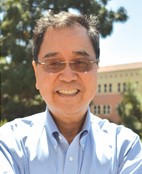
Speaker: Kang Wang, Distinguished Professor and Raytheon Chair Professor
Affiliation: Departments of ECE, Physics and Astronomy, and MSE, UCLA
Majorana Fermion, Topological Insulator and Topological Quantum Computing
Quantum computer potentially offers a drastically different way of computing problems in a massively parallel way using quantum bits (qubits). Topological protection of the qubits can markedly increase the coherence of entanglement and thus make possible scaling of qubits for solving many unsolvable problems to date, including drug discovery, and anticipation and prevention of natural disasters, e.g., wild fires, earthquakes. By reducing 3 dimensional material systems to two dimension ones using Majorana particles as topologically protected qubits, such topological quantum computer may be realized.
In 1937, Ettore Majorana proposed a particle being its antiparticle. Since its inception, Majorana has been under intensive pursuit both theoretically and in experiments. Recent interest in robust topologically protected quantum computing has accelerated the experimental quest of Majorana. The talk will discuss the experimental efforts in search of Majorana. I will discuss the key physics and materials to realize dissipationless transport: quantum Hall without magnetic field, or quantum anomalous Hall (QAH); it was enabled by a long term effort in the materials growth of topological insulator. The use of QAH is of critical importance as the dissipationless edge state of QAH offers a long coherent length in mm length scales; this is the key for scaling to a large number of quantum bits. When the QAH edge states interface with a superconductor, the Dirac electron space is transformed to the Nambu space, hosting Majorana fermions via pairing energy of the superconductor. Our recent experimental results show the convincing evidence of the half-integer quantized conductance plateau (0.5 e^2/h) for the chiral Majorana fermion at the proper topological phase transitions using a QAH/superconductor heterostructure. This half-integer quantized conductance plateau (0.5 e^2/h) gives a firm signature of the elusive Majorana fermion for the first time. More recently, the half-integer quantized conductance was also realized in a similar InSb nanowire and a superconductor heterostructure. Our finding offers a new direction for robust topological quantum computing for resolving the de-coherence challenge.
About the Speaker
Dr. Kang L. Wang is currently a Distinguished Professor and the Raytheon Chair Professor in Physical Science and Electronics at the University of California, Los Angeles. He is affiliated with the Departments of ECE, MSE and Physics/Astronomy. He received his B.S. degree from National Cheng Kung University (Taiwan) and his M.S. and Ph.D. degrees from the Massachusetts Institute of Technology. He is a Fellow of the IEEE, an APS Fellow and a Guggenheim Fellow. He is a Member of Academia Sinica. His awards include the International Union of Pure and Applied Physics Magnetism Award and Néel Medal, the IEEE JJ Ebers award for electron devices, Pan Wen Yuan Outstanding Research Award, Semiconductor Industry Association Award, the IBM Research Award, and others. He served as Editor-in-Chief of IEEE TNANO, editor of Artech House, Consulting Editor for Spins, and Associate Editor for Science Advances. His research areas include nanoscale physics and materials; topological insulators; molecular beam epitaxy; spintronics and low dissipation devices; and neurodynamics and neurotronics.
Date/Time:
Date(s) - Apr 20, 2018
10:30 am - 12:00 pm
Location:
2101 Engineering V
420 Westwood Plaza Los Angeles CA 90095
